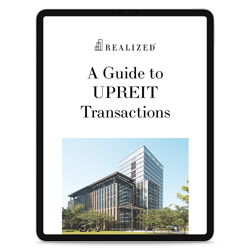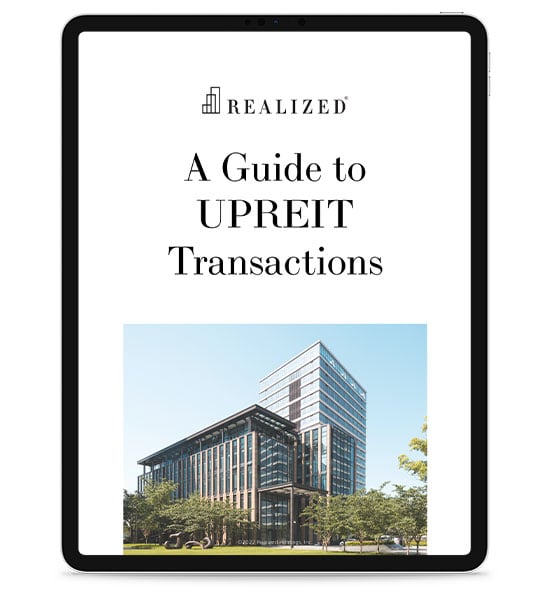
For investors who want more options than what is provided by a 1031 exchange, a 721 exchange is a great alternative. Just like a 1031 exchange, you’ll be able to take advantage of tax deferral on gains.
How Does A 721 Exchange or UPREIT Work?
A 721 exchange, also called a UPREIT (umbrella partnership real estate investment trust), allows investors to contribute property to a REIT in exchange for units in an operating partnership that will then be converted into shares of the REIT itself. Basically, an investor can sell a property to a REIT in exchange for shares in the REIT.
What Are The Benefits Of A 721 Exchange?
A 721 exchange offers several potential benefits:
- No replacement property — investors don’t have to worry about identifying replacement property like they would in a 1031 exchange.
- Some UPREITs can tailor fit the amount of debt (up to 50%) to fulfill exchange requirements.
- Passive income — as an investor in a REIT, there are no property management responsibilities. Investors will receive communication from the REIT management team about daily operations but don’t have to get involved. Additionally, investors will receive income in the form of dividends or distributions, providing consistent cash flow.
- Capital gains and depreciation recapture tax deferral — like a 1031 exchange, investors can defer taxes on their gains and depreciation recapture. This provides more proceeds for investing in the REIT.
- Diversification — REITs invest in many geographically dispersed properties. Rather than reinvesting all of your sales proceeds into another, the investor can benefit from exposure to a diverse portfolio.
- Liquidity & convenience — REIT shares are much easier to buy and sell compared to physical real estate property.
- Estate planning — Passing direct real estate ownership to heirs can result in conflicts over decision making and the division of those assets. Additionally, selling physical real estate can be difficult and time-consuming. A 721 exchange can be beneficial in estate planning because it gives the investor the ability to split the ownership interest among heirs as necessary. It then also gives the heirs the option to either hold the REIT shares or liquidate them. Since REIT shares are received through a trust, heirs get a step-up basis and avoid the estate’s deferred capital gains and depreciation recapture taxes.
Combining A 1031 Exchange With A 721 Exchange
Investors can run into restrictions when trying to move property gains into a REIT, due to specific acquisition criteria of the REIT. All REITs have this restriction. If an investor faces these restrictions, they can combine a 1031 with a 721 exchange. One way that has become increasingly popular is by completing a 1031 exchange into a Delaware Statutory Trust (DST) sponsored by a REIT that has the option to complete a 721 exchange after a stated amount of time. Using this technique, investors can acquire a fractional interest in an institutional-grade property, thus meeting the REITs criteria.
To maintain the 1031 exchange, the fractional investment must be held for about 24 months. During this holding period, investors can still receive cash flows from the fractional investment, assuming dividends are paid. Once sufficient time has passed, the investor can exchange the value of the fractional interest for operating partnership units in the REIT. As previously mentioned, these units will then be converted into equivalent REIT ownership shares.
A 1031 exchange can be repeated into perpetuity in order to defer capital gains, but REIT shares are not eligible for a 1031 exchange. When a 721 exchange is completed, it is the last time the capital gains taxes can be deferred. Once the REIT shares are sold, or the REIT returns capital to its investors (other than dividend payments), the investors will then have to recognize the capital gain and pay taxes on it.
DSTs also could have liquidity events starting at year four. From there, other common liquidity events occur at years 5-7 and 7-10, depending on the DST. Staggering DST maturities can allow for rolling liquidity events, similar to CD laddering.
Information is based on data gathered from what we believe are reliable sources. It is not guaranteed as to accuracy, does not purport to be complete and is not intended to be used as a primary basis for investment decisions. It should also not be construed as advice meeting the particular investment needs of any investor.
There is no guarantee that companies that can issue dividends will declare, continue to pay, or increase dividends.
Diversification does not guarantee a profit or protect against a loss in a declining market. It is a method used to help manage investment risk.
REITs receive special tax considerations and typically offer investors high yields, as well as a highly liquid method of investing in real estate. There are risks associated with these types of investments and include but are not limited to the following: No secondary market may exist for the security. Potential difficulty discerning between routine interest payments and principal repayment. Redemption price of a REIT may be worth more or less than the original price paid. Value of the shares in the trust will fluctuate with the portfolio of underlying real estate. Involves risks such as refinancing in the real estate industry, interest rates, availability of mortgage funds, operating expenses, cost of insurance, lease terminations, potential economic and regulatory changes.



